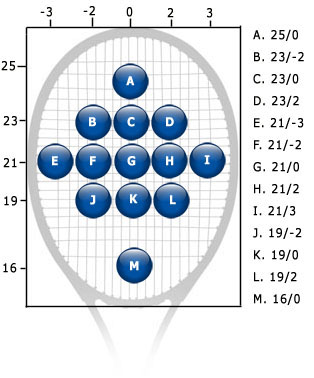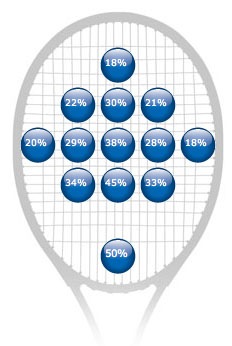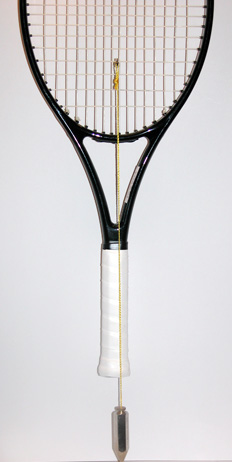
| ||
|
Often, perhaps more times than not, the power is not the same on the left and right sides of the racquet. At mirror locations, say 21/-3 and 21/3, the power may be, in extreme cases, 2-3% different (9% and 12%, for example). More often it is about 1%. Some small variations can simply be relics of experimental variation and margin of error, but most often if will simply reflect the reality that one side is more powerful than the other. Because players will hit both sides of the racquet, we report the racquet power as the average of the two mirror-opposite locations. But on any given shot launching from these locations, you will feel some to be more or less satisfying than others, and you might incorrectly and anxiously blame this on your technique. Below right is an example of an unbalanced racquet. You can see that the left side is more powerful than the right.
A consequence of this power imbalance is that the geometrical center of the racquet is no longer the power centerline of the racquet. The "left and right" dividing line, as far as power is concerned, is shifted toward the most powerful side. This power lopsidedness can be caused by a number of factors — unequal side-to-side string tensions, frame stiffness, weight, or weight distribution. The most likely culprit is weight distribution. What this means is that the left-right balance point (longitudinal balance) does not go directly through the center of the racquet (from tip to butt). The usual method of measuring the balance (along the length to determine whether the racquet is head light, head-heavy, or evenly balanced) is easy. You simply find the location between the tip and the butt where the racquet will balance on a straight edge running across the racquet (see photo). This method is virtually impossible to do accurately with the straight edge lined up from tip to butt. The racquet is too tipsy. A better method is illustrated in the following photo.
Hang the racquet on a hook or dowel along the geometric center of the racquet, and in front of that hang a plumb bob. By comparing the line "drawn" by the plumb line against the visual centerline of the racquet, you can determine if one side is heavier than the other. If the centerline of the butt is a little to the left of the plumb line, then the right side of the racquet face is heavy (as in the photo); if it is the right of the plumb line, then the left side is heavy. The visual difference might be slight. However, a couple of millimeters may reflect and couple of percent difference in power. Also, if you hang the racquet from its tip or the top string, the plumb line will indicate the weight-determined centerline of the racquet. Off-centeredness obviously has implications for customization. Racquets should be balanced left and right, using the least amount of weight possible so that swingweight is not affected. This is the subject of another article. |






